Rhinoceros iguanas are a fantastic challenge for reptile keepers looking to keep larger lizards.
This intelligent lizard has a lot of personalities compared to other species. They are pretty hardy and are very long-lived, making them best for someone who has experience in keeping large reptiles like monitor lizards or other iguana species.
They are not as vibrant as other species of iguana, like the green or blue iguana, but still, have a very unique appearance and personality.
In this article, we will cover basic information about the rhino iguana, how to care for this species, what to feed them, common health issues, and how to safely handle this iguana species.
Does this lizard sound like one you could handle? Keep reading to find out!
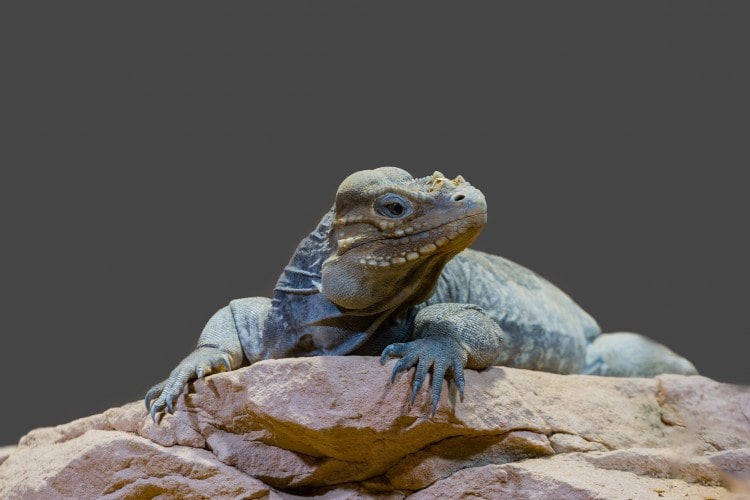
Rhino Iguana Overview
The rhino iguana, or Cyclura cornuta, is a species of iguana native to the Caribbean islands of Hispaniola, Haiti, and the Dominican Republic.
They belong to the Iguanidae family, which, as the name implies, is the iguana family. The rhino iguana usually lives about 20 years in captivity or between 10 and 15 years in the wild.
The rhino iguana, discovered in 1789 by Pierre Joseph Bonnaterre, gets its name from the small protrusion on the nose of the males, which resembles a rhinoceros’s horn.
Rhino iguanas are usually a dull brown/green to blue/gray, helping them to blend in with their rocky, arid surroundings.
Rhino iguanas are listed as an endangered species on the IUCN red list, meaning that their populations are declining, and they are seriously at risk of becoming extinct. Because of this, only captive-bred rhino iguanas are legal to own.
Before purchasing your new iguana, it is crucial that you make sure that you are purchasing from a reputable breeder and are not purchasing an illegally collected wild iguana.
Almost all species of iguanas possess the same two defense mechanisms: their bite and their tails.
The rhino iguana’s tail, like the green iguana’s, is very thick and muscular. When threatened, they may strike the threat repeatedly with their tails, using it almost like a whip. Being struck with the iguana’s tail can be very painful and can leave welts or bruises.
The iguana’s second primary defense mechanism is its bite. Iguanas have very sharp teeth and a powerful bite that can easily send you to the emergency room for stitches. These are really the only two ways the iguana can defend itself from attackers.
Despite such a scary arsenal, rhino iguanas are actually fairly docile compared to other iguana species, such as the green iguana. Rhino iguanas are much less likely to bite you or strike you with their tails, but still use extreme caution.
If you do decide that you want to purchase a rhino iguana, setting up the habitat correctly is key.
Rhino iguanas require a large enclosure that you will likely have to build yourself or order from someone who builds custom enclosures. They need an enclosure that is at least 8 feet in length and 5 feet tall, which gives this large species plenty of room to move around.
They need a substrate such as a coconut fiber or eco earth that will hold humidity well. Rhino iguanas do not need as high humidity levels as their cousin the green iguana, but still require about 60%-70% humidity.
They will also need a bowl large enough for them to soak their entire body, plenty of branches or other structures to climb on, and multiple heat lamps and UVB bulbs to properly bask and maintain high temperatures.
Getting To Know the Rhino Iguana
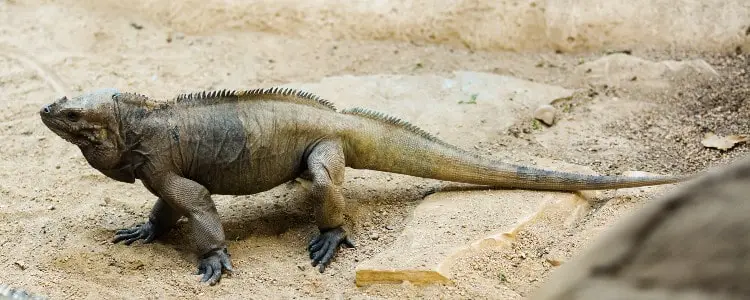
Pros
- Rhino iguanas can live for a long time
- This is a very unique pet and is not commonly seen in the pet trade
- This species is smaller than some of the other iguanas, making it easier to handle
Cons
- Rhino iguanas are endangered in the wild
- This iguana species is very high-maintenance
- Iguanas have a powerful bite and could seriously injure someone
Appearance
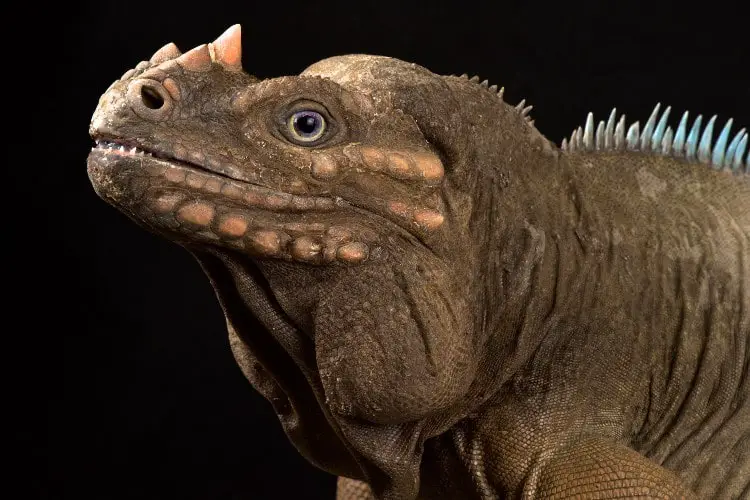
Looking at rhinoceros iguanas, it is very easy to see how they get their name. Rhino iguanas have a horn-like protrusion on their noses, which is very similar to the horn of a rhinoceros.
In addition to their “horns,” rhino iguanas also have a similar head shape and body color to their mammalian namesake.
Rhino iguanas range in color from a dull brown to a murky green to steely gray, or a mix of the three. Their dull color helps them to easily blend in amongst rocky areas, leaf litter, and sandy areas.
Many people find rhino iguanas to be very prehistoric in appearance, with large bodies, a row of spines down their backs and part of their long tails, a triangular head, and long, massive claws.
Rhino iguanas can grow to be as large as 4.5 feet long and weigh from 10-20 lbs. Like other iguana species, they have a very slow growth rate and can take 2-3 years or longer to reach their full size.
Just by looking at a sexually mature rhino iguana, it is easy to tell the difference between males and females. Male rhino iguanas are generally larger than females, have a larger pseudo-horn, and have thicker, larger jowls. This difference in appearance between male and females of the species is known as sexual dimorphism.
In order to sex baby or juvenile rhino iguanas, you will need to either probe them or take them to a veterinarian for an x-ray.
Probing is when a special tool is inserted into the vent of a reptile to determine the presence or absence of the hemipenes, which is the sexual organ of male reptiles. Probing can be very harmful to your pet if done incorrectly, so this is best left to someone experienced with this practice or a veterinarian.
A less invasive, albeit more expensive, option is to take your reptile to your local exotic animal veterinarian for an x-ray. The vet can locate the sexual organs on the x-ray and tell you for sure whether you have a male or female.
Care & Husbandry Guide
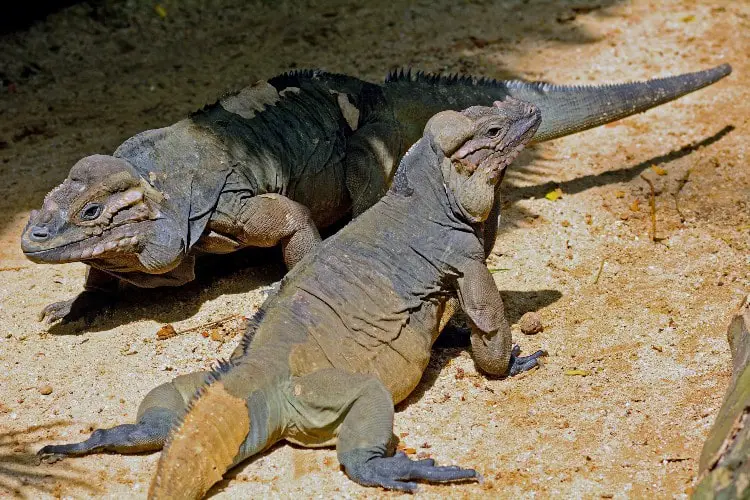
Rhino iguanas are very high-maintenance and expensive pets. They have a lot of specific needs in terms of heating and lighting and require an enclosure larger than most people can provide.
This species is not for beginner reptile keepers or for a household that has young children. Rhino iguanas have a powerful bite that could easily send someone to the hospital.
The rhino iguana is native to tropical islands, so they require relatively high humidity and heat. Their humidity and temperature levels are very expensive and difficult to maintain, but if you have the budget, space, and experience, this iguana can be a very unique and rewarding pet.
What To Feed A Rhino Iguana?
In the wild, rhino iguanas are primarily herbivorous, but will occasionally eat small insects or other bugs. Rhino iguanas are diurnal and spend most of the day eating and basking.
They can eat a wide variety of plants, fruits, flowers, and seeds. In captivity, they are pretty easy to feed.
Most people stick to a rotated diet, where they feed the iguana mainly a large handful of leafy greens, supplemented with a variety of chopped fruits and vegetables.
Fruits should be fed in very small amounts, as the high sugar levels is not healthy in large quantities. Fruits should not make up any more than 10% of your iguana’s diet.
The most important thing to remember when gathering food for your iguana is that you should only feed items you buy from a grocery store or pet store. Anything from the outdoors can contain parasites or diseases that could be harmful or fatal for your iguana.
One of the biggest feeding mistakes people make with the rhino iguana is feeding too many insects. While iguanas do occasionally eat bugs, their bodies are made to digest and process plant material. Insects should not be used to bulk up the iguana’s diet and can make them sick in large quantities due to malnutrition.
In addition to the proper foods, rhino iguanas also need a calcium powder supplement to prevent metabolic bone disease.
Rhino Iguana Food List:
- Mustard greens
- Kale
- Turnip greens
- Collard greens
- Dandelion greens
- De-thorned cactus pads
- Carrots
- Bell peppers
- Squash
- Broccoli
- Cucumber
- Peas
- Green beans
- Sweet potatoes
- Dandelion flowers
- Hibiscus flowers
- Apples
- Mangos
- Bananas
- Blueberries
- Plums
Rhino Iguana Lifespan & Health Concerns
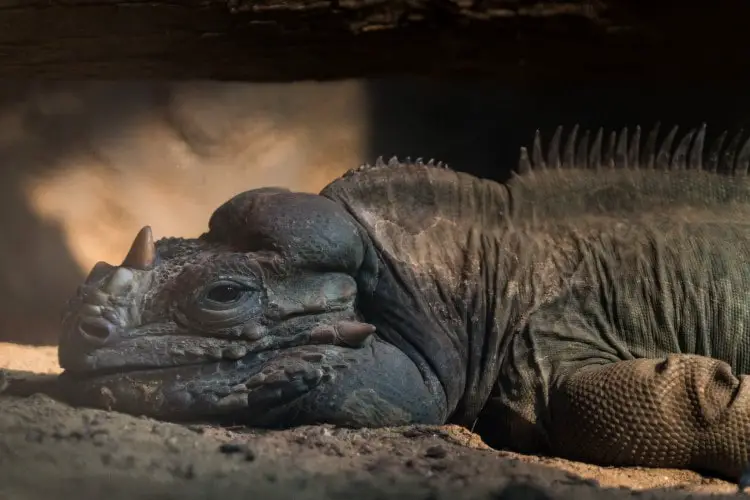
Rhino iguanas are a pretty hardy species if provided the proper habitat conditions and nutrition, but they can become very ill if they are not properly cared for.
Under the correct conditions, rhino iguanas can live 16-17 years. The main health concerns for rhino iguanas come from improper humidity levels, improper heating and lighting, and improper diet.
The wrong humidity levels can make just about any reptile sick. Iguanas are commonly brought to veterinarians with upper respiratory infections caused by humidity levels that are not high enough.
Rhino iguanas require 60%-70% humidity to stay healthy. Low humidity levels can cause respiratory infections, stuck shed, and dehydration.
Respiratory infections are very dangerous to reptiles, usually causing a build-up of mucus in the lungs that can be fatal if left untreated.
If your iguana has nasal discharge or discharge from the eyes or mouth, wheezing, is open-mouthed breathing, or is very lethargic, you should take your iguana to the vet to have it checked for a respiratory infection.
Stuck shed is another common issue resulting from low humidity. If shed skin gets stuck over the eyes, nostrils, toes, or the tip of the tail, it can cause a lot of damage.
Many iguanas, especially young ones, lose toes or the tips of their tails from shed skin that got stuck and cut off circulation. Proper shedding is very important to an iguana’s health.
Perhaps the most notorious health concern for iguanas and most other reptiles is metabolic bone disease.
Metabolic bone disease results from low calcium levels. When the body does not have enough calcium, it will begin to leech it from the bones, causing weakened bones.
If left untreated long enough, it can cause deformities in the skeleton, fractured bones, weakness and lack of muscle tone, and even seizures.
If left untreated, it will kill your iguana.
Metabolic bone disease is easily avoided by providing a calcium supplement in the iguana’s diet as well as UVB lights.
Signs They Are Healthy & Happy
- Your iguana has a healthy appetite
- Iguana is alert and frequently moves around its enclosure
- The iguana sheds regularly and has normal bowel movements
- The iguana has clear, dry eyes and dry nostrils
Sickness Symptoms
- The iguana refuses food and does not have a good appetite
- Their body has no muscle tone and limbs feel limp/flaccid
- The iguana does not move around much
- Your iguana is wheezing or has discharge in the eyes or nostrils
How To Set Up A Rhino Iguana’s Habitat?
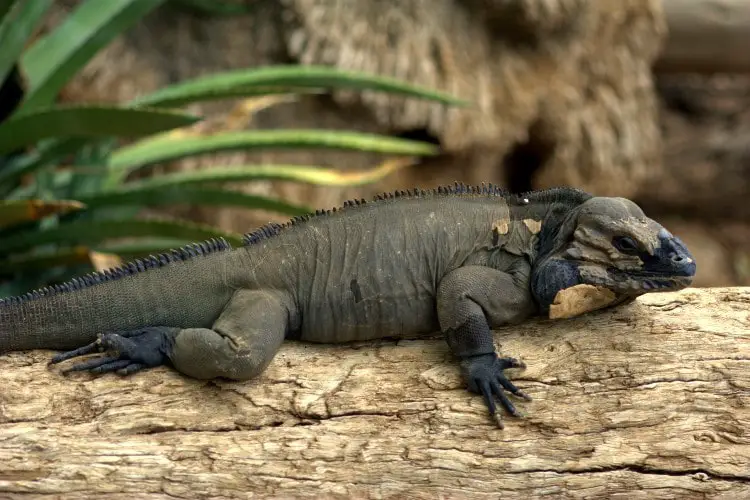
Rhino iguanas are native to the Caribbean islands of Hispaniola, Haiti, and the Dominican Republic, which means they are accustomed to and thrive in relatively high heat and humidity.
Rhino iguanas are a terrestrial species, meaning they spend the majority of their time on the ground as opposed to in trees like many of their cousins.
Rhino iguanas are diurnal, so providing UVB lighting as well as a well-lit enclosure is very important.
Rhino Iguana Husbandry Tips
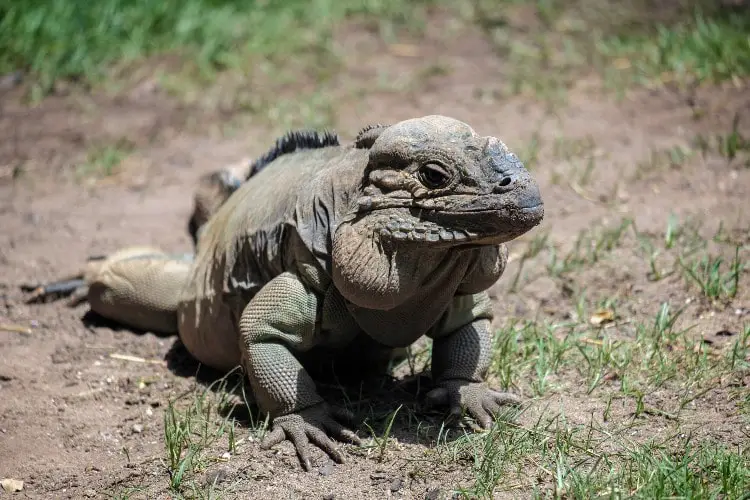
The biggest thing that discourages people from keeping iguanas is their need for a massive space. Adult rhino iguanas require an enclosure at least 8 ft long and 5 ft tall, providing them with ample room to move around.
Because of the amount of space needed, you will almost definitely need to build your own enclosure or purchase one from a company that creates custom-built enclosures.
Rhino iguanas need a substrate that is excellent at holding humidity. Rhino iguanas require 60%-70% humidity.
Something like coconut fiber or eco earth is ideal for achieving these levels and could also be used to plant some vegetables or leafy greens in the enclosure for your iguana to feed on whenever it gets hungry.
A thick layer of substrate will be ideal, as many iguanas also enjoy digging. Investing in a hygrometer will help you monitor the humidity and make sure it is high enough.
Lighting for your rhino iguana will be one of the most expensive components of the enclosure. Because they get so large, multiple heat lamps and UVB lights will be necessary if your enclosure is inside.
If you use only one heating lamp, your reptile will spend a lot more time sitting under it trying to heat its entire body. Having this heat concentrated on just one part of your iguana’s body for a long period of time can cause a burn.
Instead, you will need 3-4 heat lamps clustered together to create a larger basking spot that your iguana will not have to spend as long under, thus reducing its risk of getting burned. You will need the same number of UVB lights to make sure your iguana is being provided with enough UVB to prevent metabolic bone disease and to keep your iguana happy and healthy.
An indoor enclosure needs to maintain an ambient temperature of around 80 degrees with a basking or hot spot temperature of 90-95 degrees. You will need a thermometer placed both in the basking area and the middle of the enclosure to make sure your temperatures are correct.
If you choose an outside enclosure, you may not need heating or lighting at all during warmer months. Outside enclosures should provide a structure that provides shade, a structure that gets hit with direct sunlight (not through glass or plastic) for basking, and somewhere to take shelter from bad weather.
Rhino iguanas also love to soak, so they will need a water dish large enough to fit their entire body. They will also need rocks or branches that they can climb around on and areas that they can use to hide.
Adding plants to the enclosure is a good way to help maintain humidity as well as to provide your iguana with snacks throughout the day. Just make sure that the plants are non-toxic before placing them in your iguana’s enclosure.
Rhino Iguana Behavior
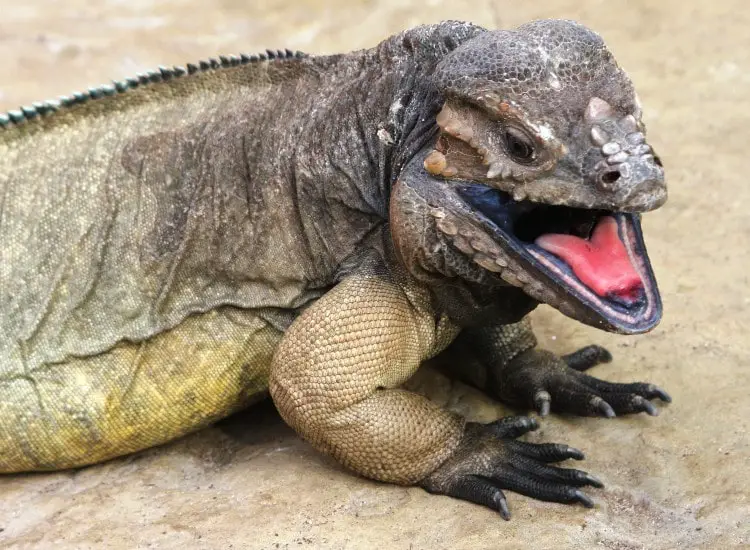
Rhino iguanas are one of the more docile iguanas in the pet trade, but they can still be quite moody and difficult to work with, especially if they were not well-socialized at a young age.
In the wild, they spend the majority of their time basking or foraging for food. Iguanas are a territorial species, meaning that they will claim and defend a piece of land. The more aggressive the male iguana, the larger the territory they will have.
Male iguanas can constantly be seen head bobbing, hissing, puffing out their dewlaps and bodies, and whipping their tails to try and warn other males to leave. If the warning is not heeded, they will likely fight, using their teeth and tails to attack each other.
Head bobbing is also seen in iguanas in captivity. Slow head bobbing can be a greeting, but rapid, shallow bobs are likely an indication that your iguana is upset and does not wish to be disturbed. They may also puff up their bodies to appear larger or extend their dewlap.
If your iguana exhibits any of this posturing, it is best to simply leave them alone.
Another sign of fear or stress is if your iguana tightly squeezes the eye facing you shut. Sometimes they will close one eye to avoid seeing whatever is in front of the closed eye. While they will close their eyes when relaxing, too, it is easy to tell the difference based on the body posture.
If the iguana’s eyes are closed but it is sitting up stiffly, it is probably stressed. If the iguana’s eyes are closed and the body is relaxed and closer to the ground, they are probably just enjoying your company.
Most rhino iguanas are very relaxed and amicable in captivity, which is why they are a popular alternative to the moodier green iguana.
Many even enjoy being scratched under the chin or being held by their keeper, similar to a cat.
Handling Safety
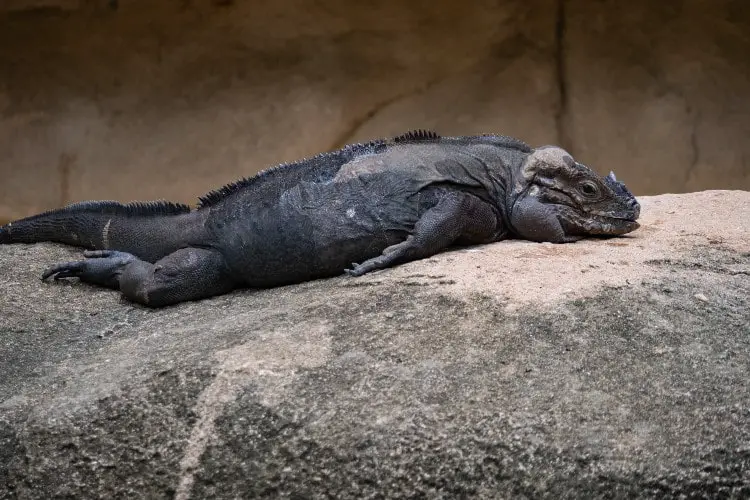
Rhino iguanas can be safely handled as long as they are well-socialized, but it is always important to be sure to pay attention to their body language.
A grouchy iguana can send you to the hospital if you aren’t careful.
It is best to purchase an iguana as a baby, when they are too small to do much harm to you if they bite you. Short handling sessions a few times a day will help get your iguana used to being held without stressing them out too severely.
Adult iguanas can still do a lot of damage, even if they aren’t trying to. Their long claws, used to help them climb, can easily tear up your arm.
When holding your iguana, especially if it is an adult, you can hold it firmly against your body with one hand supporting the chest and the other supporting the rear legs and tail to help minimize the scratches you may receive.
Other people like to simply let their iguana ride around on their shoulder, but just be careful not to let them try to climb on your head, as a stray claw in your eye could literally blind you.
One of the most important things to keep in mind when handling your iguana is to never, ever hold them by the tail. Iguanas can drop their tails, but they can only do it once and it is very stressful for them to do so.
Buying A Rhino Iguana
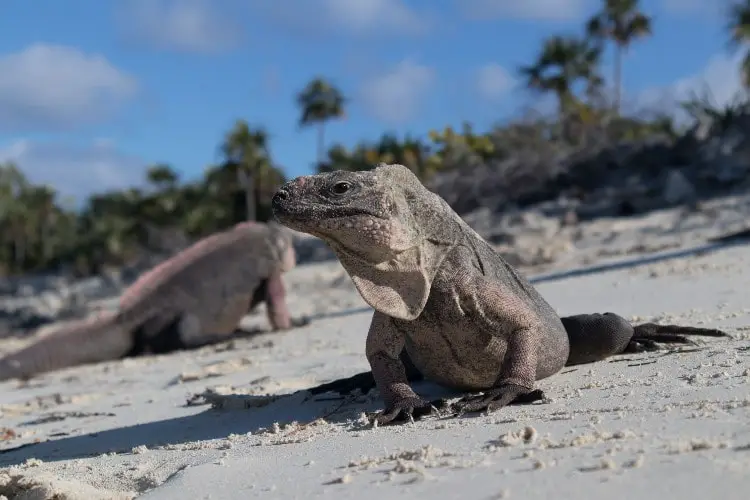
Rhino iguanas are very difficult to find for sale since they are endangered. They can only be legally bought if they are captive-bred.
You will likely need to look online to find a rhino iguana, as they are very rarely found in pet stores or at reptile expos.
When looking for a breeder to purchase from, be sure to carefully read customer reviews, to ask the breeder questions about the iguana and how old it is, information about the parents’ genetics, etc.
A good breeder will likely also question you to ensure that you know how to care for the iguana. Good breeders care a lot about their animals and make sure they will be going to a new home.
Picking a healthy animal online can be more difficult, but you should be able to request pictures and videos of the iguana to check for nasal discharge, discharge from the eyes, any new or old wounds, and to be sure the iguana looks alert.
How Much Does A Rhino Iguana Cost?
The rhino iguana itself will usually cost you somewhere between $550 and $800. They are very difficult to find since you can only legally purchase captive-bred rhino iguanas.
Total cost for the enclosure is very difficult to estimate due to the sheer size you need and due to how varied the costs for custom enclosures are, but it would be wise to save $2-$3k if you are buying a custom-built enclosure and having it shipped to you.
If you are building your own, you may be able to construct one for half the cost or less, but it would be best to purchase one from a reputable company, as they will know how to build the enclosure to make it as safe as possible for your iguana.
After the enclosure itself, you will need 3-4 heat lamps, which will cost you around $50-$60 for the bulbs and $60-$75 for the lamp that holds the bulbs. You will also need 3-4 UVB bulbs and lamps for the bulbs, which will cost about $50-$60 and $60-$75 respectively. The UVB bulbs need to be replaced every month to work effectively.
You will also need to buy a large water dish or pool, which can cost from $10-$50 depending on how fancy of a dish you want. Many people simply choose to buy kiddie pools for their iguana, but if you want a more natural-looking water source, it will be more expensive.
Finally, you will need rocks, plants, and other decorations for the tank which can cost from $100-$500, again, depending on how fancy you want to get. You can collect rocks and branches from outside to use to save money, but they will need to be baked in the oven for a couple of hours first to kill any parasites or diseases they may contain.
Overall, to keep a rhino iguana, you will need to be prepared to spend thousands of dollars on the initial setup, and then about $300 a month on food and lighting.
Rhino Iguana Facts
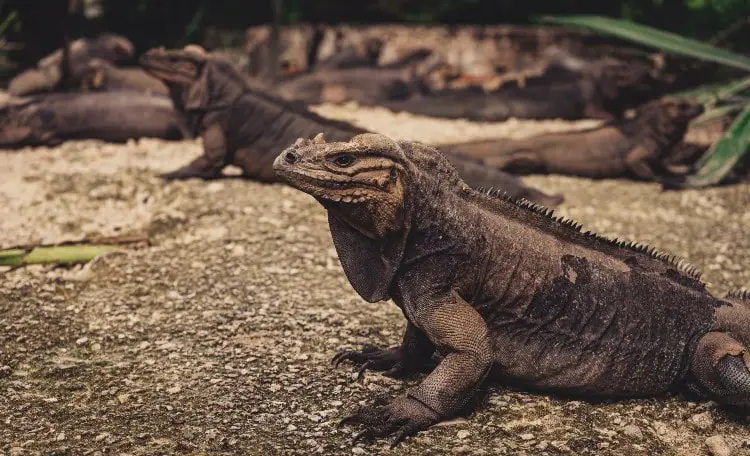
| Common Name (s) | Rhinoceros iguana, rhino iguana |
| Scientific Name | Cyclura cornuta |
| Family Name | Iguanidae |
| Genus Name | Cyclura |
| Range | The Caribbean islands of Hispaniola, Haiti, and Dominican Republic |
| Adult Size | Up to 4.5 feet long and 10-20 lbs |
| Lifespan | 16-17 years in captivity |
| Similar Species/Popular Alternatives | Rock iguana, green iguana, black and white Argentine tegu |
Summary:
With their dinosaur-like appearances, it is easy to see why rhino iguanas intrigue so many people.
Because they are so expensive to purchase and so difficult to care for, few people choose to buy their own rhino iguana, but those who do frequently rave about what intelligent and incredible pets they are.
Rhino iguanas require a massive enclosure, high heat and humidity, and plenty of UVB light.
They are usually pretty tame and will readily tolerate handling and petting, especially if they were well-socialized as babies.
Due to their size and ability to hurt someone if they are in a foul mood, this species is not recommended for beginners. They require highly experienced keepers who are used to working with large lizards.
If you can afford to keep one of these prehistoric beasts, you will be rewarded with a lizard who is highly intelligent, can be trained, and many enjoy cuddling and scratches under the chin.
Does the rhino iguana sound like a good fit for you?
Let us know in the comments!









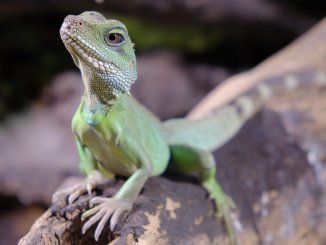
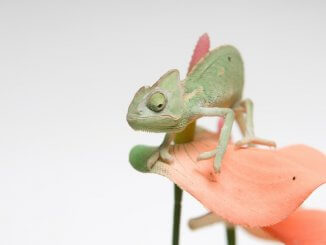
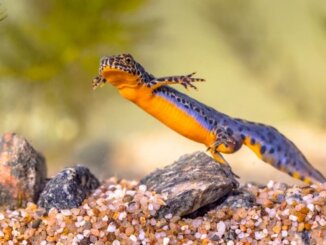

We are super excited to welcome our first rhino iguana to our home! Ty Park has several clutches set to hatch in October, and we’ll be getting a male and his name will be Sully. We live in Florida, so we’ll have no problem providing heat and humidity!
this is not a lizard. This is a DRAGON
All iguanas and members of the Iguanidea Family are lizards. Dragon is a commonly used term to describe crested lizards, but there is nothing scientific about the term. They certainly look like mini-dragons though!